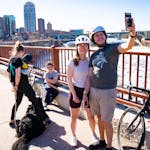Two men were gunned down in separate incidents early Tuesday on Minneapolis' South Side in the city's 48th and 49th homicides of 2020 — eclipsing the number killed from all of last year.
There were 24 killings by this time in 2019, and the year ended with 48. The state's largest city could be headed for its most violent year in at least two decades.
The spike in homicides mirrors a similar trend in other large U.S. cities, which have seen violence rise during the coronavirus pandemic and a national backlash over police brutality that followed the death of George Floyd.
A Wall Street Journal analysis found double-digit increases in homicides in 36 of the county's 50 largest cities since the pandemic hit — and while shootings and gun violence also rose, other violent crimes such as robbery fell, the analysis found.
In Minneapolis, though, crime numbers have shot up almost across the board. Violent crime, for example, has risen nearly 20% from this time last year, as homicides, robberies and aggravated assaults like shootings and stabbings have all gone up. Only the number of rapes has declined. Property crimes have also shot up, with the exception of larcenies.
But those who study crime trends cautioned against reading too much into such spikes, pointing out that homicide counts can sometimes fluctuate wildly from one year to the next. Others say that overall crime has continued to trend downward for years.
Still, local officials say even with the annual crime surge that accompanies the summer months, this year is worse than usual. And, if the pace of bloodshed keeps up, the city's 20-year high of homicides — 57 in 2006 — is within reach.
In the city's most recent slayings, officers were dispatched to a report of shots about 6:30 a.m. Tuesday. They found a man lying dead from a gunshot wound on the ground along 59th Street, just east of Nicollet Avenue. Details of what led to the shooting have not been released.
The discovery came hours after a man was shot about 12:20 a.m. near E. 46th Street and Hiawatha Avenue. In that incident, state troopers patrolling nearby heard gunfire, and a short time later stopped a vehicle that was seen speeding away from the area. Inside, they found a man who had been shot. He was taken to HCMC, where he later died.
The city's violence has been largely fueled by gang activity, according to Ashlee Sherrill, a spokeswoman for the Bureau of Alcohol, Tobacco, Firearms and Explosives. Since July, the federal agency has been part of a task force working to curb the "extraordinary spike" in violence in cities since Memorial Day. She said they are using ballistic imaging, crime gun intelligence, and other law enforcement technologies to identify the area's most prolific shooters.
The recent upswing in violence comes at a crucial time for the beleaguered Minneapolis Police Department, which finds itself grappling with a state human rights investigation, mass departures and continued calls for its defunding, or even abolishment.
A little more than a third of homicides this year have ended in an arrest, or 18 of 49, although police point out that clearance rates are fluid, and some crimes may be solved in the coming months as new evidence comes to light.
Earlier this month, the City Council adopted a revised 2020 budget that cut roughly $1.5 million from the MPD's $193 million budget — most of which was to be diverted to the Office of Violence Prevention. Some of that money may be used to fund civilian patrols across the city, as well as to launch a new violence prevention initiative patterned after the Cure Violence program that uses trusted "messengers" to mediate street conflicts.
The city has also been thrust into the national political debate, as President Donald Trump has repeatedly blamed rising crime on the city's Democratic leadership, most recently at a campaign stop in Mankato on Monday.



